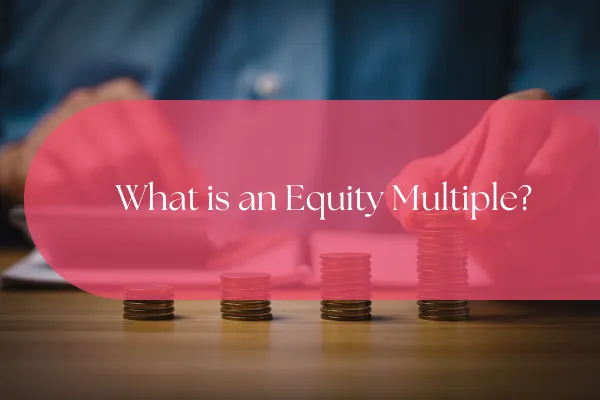
What is an Equity Multiple?
What is an Equity Multiple?
An equity multiple or multiple on invested capital (MOIC) is a vital tool used to measure the profitability or return on an investment, particularly in real estate. It provides a clear, straightforward way to understand how much return an investment generates relative to the amount of capital invested.
The equity multiple is calculated using the following formula:
Equity Multiple = Total Distributions / Total Equity Invested
Key Components
Total Distributions: This includes all the cash flows received from the property during the hold period (such as rental income) and the net proceeds from the sale of the property, less any loan repayments.
Total Equity Invested: This encompasses all the equity used to purchase the property, as well as any additional costs such as refurbishment or operating expenses.
Interpreting the Equity Multiple
An equity multiple of 1.0x means that the total cash returned is exactly equal to the amount that was put in. A multiple of less than 1.0x means that less cash has been returned that was put in, and that the investment has made a loss. Conversely, an equity multiple greater than 1.0x signifies a profit.
Example Calculation
Initial purchase price including costs: £10,000,000
Capex: £5,000,000
Annual Net Operating Income: £500,000
Net sale price after 4 years: £22,000,000
Total Distributions = £500,000 x 4 + £22,000,000 = £24,000,000
Total Contributions = £10,000,000 + £5,000,000 = £15,000,000
Equity Multiple = £24,000,000 / £15,000,000 = 1.6x
This means that for every £1 invested, you receive back £1.60
Impact of Leverage on Equity Multiple
Example Calculation
Consider the above example, but with a £5,000,000 loan and annual interest payments of £250,000.
Total Distributions = (£500,000 - £250,000) x 4 + £22,000,000 = £23,000,000
Total Contributions = £10,000,000 + £5,000,000 - £5,000,000= £10,000,000
Equity Multiple = £23,000,000 / £10,000,000 = 2.30x
This means that for every £1 invested, you receive back £2.30
In this scenario, leverage has increased the equity multiple, indicating a higher return relative to the equity invested. However, it’s crucial to remember that leveraging can amplify both gains and losses, depending on the cost of debt and the performance of the investment.
Equity Multiple and the time value of money
While the equity multiple is a useful metric for comparing the profitability of different investments, it has a significant limitation: it does not account for the time factor. For example, an equity multiple of 2.00x does not specify whether this return is achieved in 1 year, 5 years, or 100 years. To address this, the equity multiple should be used alongside the Internal Rate of Return (IRR), which considers the time value of money. The IRR provides a more comprehensive understanding of an investment's performance over time.
Considering Risk Factors
Neither the equity multiple nor the IRR inherently account for risk. A thorough due diligence process is essential to assess the risks involved in a potential investment. High equity multiples can sometimes mask underlying risks such as poor property location, low-quality construction, or market volatility. Evaluating these risks is crucial to making informed investment decisions.
Conclusion
The equity multiple is a powerful and straightforward metric to assess the potential profitability of real estate investments. It helps investors quickly compare different opportunities and gauge their returns relative to the capital invested. However, it should not be used in isolation. Combining it with metrics like IRR and a comprehensive risk assessment provides more robust analysis and helps ensure better investment decisions.
Thank you so much for reading. If you want more content, join our free membership in The EiP Academy – http://academy.excelinproperty.com/join